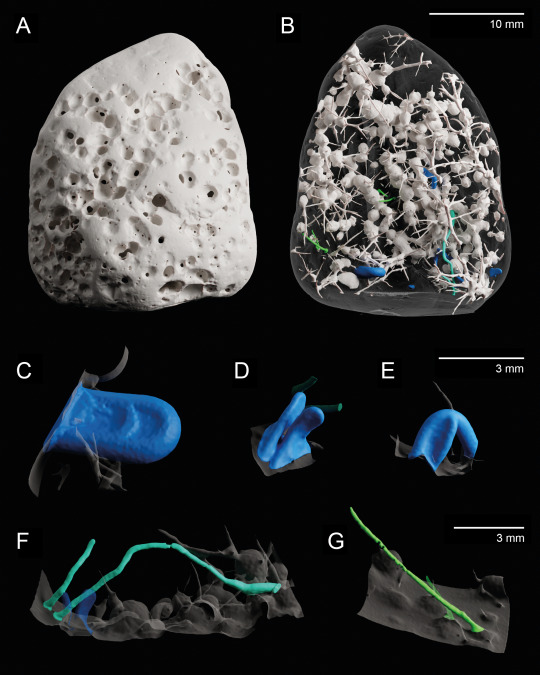#caulostrepsis
Text

X-ray microtomography 3D model of a bioeroded limestone pebble given to me by a friend who wanted to know what the holes were. Not technically art but I think it looks cool.
I identified 4 distinct types of borings (ichnotaxa) in this 3-cm pebble:
Entobia cf. cretacea (white): typical sponge borings, composed of interconnected chambers and exploratory threads; by far the dominant ichnotaxon in the sample (97% of bioeroded volume).
Caulostrepsis taeniola (blue): U-shaped borings made by polychaete worms (e.g. spionids).
Unnamed Caulostrepsis ichnospecies (cyan): long and tightly U-shaped borings, possibly also made by polychaete worms.
Trypanites solitarius (green): simple unbranched borings that can be produced by many different organisms (polychaetes, bryozoans, phoronids).
(A-B) Full sample. (A) External view. (B) Virtual mould of the borings. (C-G) Virtual moulds of individual borings. (C-E) Caulostrepsis taeniola (note the variability in size). (F) Caulostrepsis unnamed ichnospecies. (G) Trypanites solitarius.
Experiments with limestone bricks show that bioerosion comparable in nature and extent to the one showcased here can develop after 3-4 years (Färber et al. 2016), providing a rough estimate of the time elapsed between this rock fragment first being exposed and it washing onto the shore where my friend picked it up.
References:
Bromley, R. G. (1972). On some ichnotaxa in hard substrates, with a redefinition of Trypanites Mägdefrau. Paläontologische Zeitschrift, 46(1), 93–98. https://doi.org/10.1007/BF02989555
Bromley, R. G. (2004). A Stratigraphy of Marine Bioerosion. Geological Society, London, Special Publications, 228, 455–479. https://doi.org/10.1144/GSL.SP.2004.228.01.20
Bromley, R. G., & D’Alessandro, A. (1983). Bioerosion in the Pleistocene of Southern Italy: Ichnogenera Caulostrepsis and Maeandropolydora. Rivista Italiana Di Paleontologia e Stratigrafia, 89(2), Article 2.
Bromley, R. G., & D’Alessandro, A. (1984). The ichnogenus Entobia from the Miocene, Pliocene and Pleistocene of southern Italy. Rivista Italiana Di Paleontologia e Stratigrafia, 90(2), Article 2.
Färber, C., Titschack, J., Schoenberg, C., Ehrig, K., Boos, K., Baum, D., Illerhaus, B., Asgaard, U., Bromley, R., Freiwald, A., & Wisshak, M. (2016). Long-term macrobioerosion in the Mediterranean Sea assessed by micro-computed tomography. Biogeosciences, 13, 3461–3474. https://doi.org/10.5194/bg-13-3461-2016
#entobia#caulostrepsis#trypanites#sponge#polychaete#bioerosion#trace fossil#holocene#ichnology#ichnotaxonomy#paleontology#geology#tomography#microtomography
110 notes
·
View notes
Text
An unusual association of a Recent oyster and a slipper limpet
An unusual association of a Recent oyster and a slipper limpet
My young son and I both have a taste for oysters, and have a favourite restaurant in which we like to eat them. It is in the Spui district of Amsterdam, which is also an area with a high density of bookshops. Therefore, there is a double incentive to visit the area. When eating oysters, we are always keen to examine the shells for interesting encrustations or borings, but have never before found…
View On WordPress
#caulostrepsis taeniola#crassostrea#crepidula shell#gastropod shell#oyster#oyster beds#oysters#recent oyster#recent oysters#slipper limpet
3 notes
·
View notes